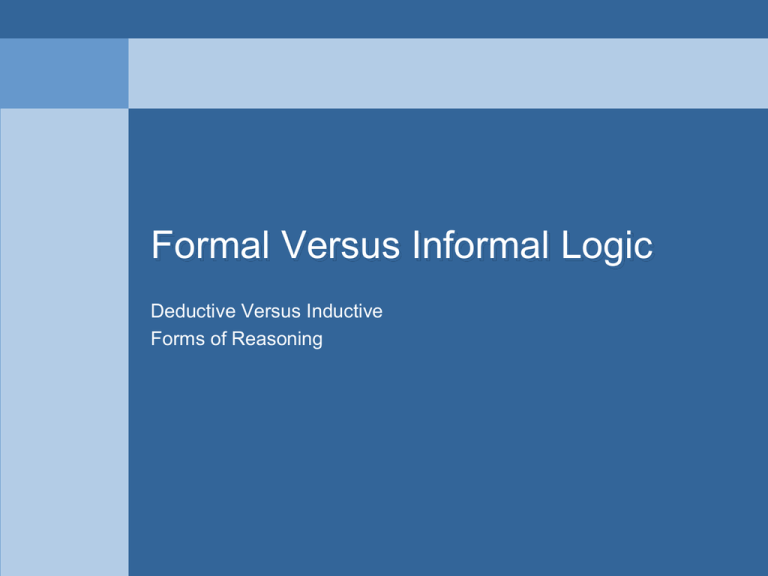Deductive Vs Inductive Reasoning PPT
advertisement

Formal Versus Informal Logic Deductive Versus Inductive Forms of Reasoning Two basic categories of human reasoning • Deduction: reasoning from general premises, which are known or presumed to be known, to more specific, certain conclusions. • Induction: reasoning from specific cases to more general, but uncertain, conclusions. • Both deductive and inductive arguments occur frequently and naturally…both forms of reasoning can be equally compelling and persuasive, and neither form is preferred over the other (Hollihan & Baske, 1994). Deduction Vs. Induction Deduction: Induction • commonly associated • with “formal logic.” • involves reasoning from known premises, • or premises presumed to be true, to a certain conclusion. • the conclusions • reached are certain, inevitable, inescapable. commonly known as “informal logic,” or “everyday argument” involves drawing uncertain inferences, based on probabalistic reasoning. the conclusions reached are probable, reasonable, plausible, believable. Deductive Versus Inductive Reasoning Deduction • It is the form or structure of a deductive argument that determines its validity • the fundamental property of a valid, deductive argument is that if the premises are true, then the conclusion necessarily follows. • The conclusion is said to be “entailed” in, or contained in, the premises. – example: use of DNA testing to establish paternity Induction • By contrast, the form or structure of an inductive argument has little to do with its perceived believability or credibility, apart from making the argument seem more clear or more well-organized. • The receiver (or a 3rd party) determines the worth of an inductive argument Inductive or deductive reasoning? • A sample of fifty motorists who were stopped by the CHP at a sobriety checkpoint on a Saturday at midnight revealed that one in four drivers were either uninsured, intoxicated, or both. Thus, if you get involved in an accident on the freeway there is a 25% chance the other motorist will be drunk or uninsured. • The Law of the Sea treaty states that any vessel beyond a 12 mile limit is in international waters. The treaty also states that any vessel in international waters cannot be legally stopped or boarded. Therefore, when the U.S. Coast Guard intercepts boats coming from Cuba or Haiti more than 12 miles from the U.S. coast, it is violating the Law of the Sea. Sample Deductive and Inductive Arguments Example of Deduction • major premise: All tortoises are vegetarians • minor premise: Bessie is a tortoise • conclusion: Therefore, Bessie is a vegetarian Example of Induction • Boss to employee: “Biff has a tattoo of an anchor on his arm. He probably served in the Navy.” sample “Venn diagram” of a deductive argument vegetarian animals tortoises Thus, Bessie must be a vegetarian All tortoises fall in the circle of animals that are vegetarians Bessie falls into the circle of animals that are tortoises Bessie Other types of deductive arguments • Suppose every place in the world that people live is represented by the blue space inside the rectangle. Suppose the long pink oval represents all the wooden houses in the world. And, suppose the green circle represents Canada. The most logical conclusion one can draw from the figure is: A. all wooden houses are found in Canada B. Everyone lives in a wooden house C. Some Canadians live in wooden houses D. No one lives in Canada Other types of deductive arguments • Suppose the following statements are all true: – Person L is shorter than person X – Person Y is shorter than person L – Person M is shorter than person Y • What additional piece of information would be required to conclude that “Person Y is shorter than Person J”? A. B. C. D. E. Person L is taller than J Person X is taller than J Person J is taller than L Person J is taller than M Person M is taller than Y Solution: Answer C M<Y<L<X So, if J is taller than L, Y must be shorter than J Other types of deductive arguments A mother wants to order one large pizza, with exactly 5 toppings for her three picky children. She can choose from 7 toppings; cheese, mushrooms, olives, ham, sausage, onions, and pineapple. – Fifi says there has to be pineapple – Mona says there cannot be any olives – Rex says that if there is going to be sausage, then there has to be ham too. Which combination of toppings should she select if she is to satisfy all three children’s combined demands? A. B. C. D. pineapple, onions, cheese, mushrooms, sausage cheese, sausage, ham, olives, pineapple cheese, mushrooms, ham, onions, pineapple sausage, mushrooms, onions, cheese, and ham. the five topping solution chee se mushro om oliv e ham sausag e Fifi Mona Rex onio n pineapp le Yes No then ham if sausa ge Note: the statement “if sausage, then ham” doesn’t imply “If ham then sausage.” The obverse doesn’t necessarily follow. Deduction Versus Induction ---continued • Deductive reasoning is either “valid” or “invalid.” A deductive argument can’t be “sort of” valid. • Inductive reasoning enjoys a wide range of probability; it can be plausible, possible, reasonable, credible, etc. • the inferences drawn may be placed on a continuum ranging from cogent at one end to fallacious at the other. • If the reasoning employed in an argument is valid and the argument’s premises are true, then the argument is said to be sound. valid reasoning fallacious + true premises = sound argument cogent Deduction Versus Induction --still more • Deductive reasoning is commonly found in the natural sciences or “hard” sciences, less so in everyday arguments • Occasionally, everyday arguments do involve deductive reasoning: Example: “Two or more persons are required to drive in the diamond lane. You don’t have two or more persons. Therefore you may not drive in the diamond lane” • Inductive reasoning is found in the courtroom, the boardroom, the classroom, and throughout the media • Most, but not all everyday arguments are based on induction – Examples: The “reasonable person” standard in civil law, and the “beyond a reasonable doubt” standard in criminal law







